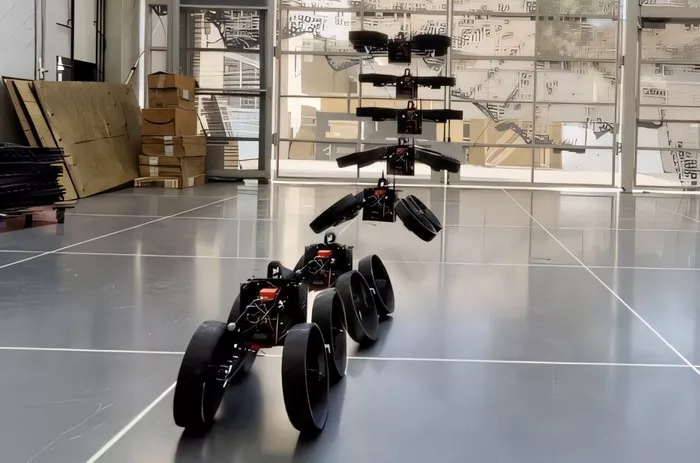Caltech engineers have developed an innovative flying robot that can transform its shape midair to switch seamlessly from flight to ground movement. Dubbed ATMO (aerially transforming morphobot), this advanced drone uses four thrusters for flight, which then fold down into wheels, allowing it to drive away smoothly — even on rough terrain where traditional flying-then-driving robots often get stuck.
Unlike previous models that must land and then physically reconfigure before moving, ATMO’s unique design relies on a single motor to rotate a central joint, shifting between drone and driving modes in midair. This breakthrough enables faster transitions and improved agility, with potential applications in commercial delivery systems and robotic exploration.
The team detailed the robot’s design and sophisticated control system in a recent publication in Communications Engineering. Lead author Ioannis Mandralis, a Caltech aerospace graduate student, explained the inspiration came from nature: “Animals like birds can alter their body shape mid-flight to slow down and avoid obstacles. That kind of transformation unlocks new possibilities for autonomy and robustness in robotics.”
However, morphing midair presents significant challenges. The complex aerodynamic forces near the ground, combined with ATMO’s four thrusters adjusting their thrust angles, create turbulent and unstable flight conditions.
Mory Gharib, director of Caltech’s Center for Autonomous Systems and Technologies, highlighted the difficulty: “Landing safely with changing body configurations has been a challenge for aerospace engineers for over 50 years. Even helicopters face issues with airflow near the ground, and ATMO’s design adds an extra layer of complexity.”
To overcome these challenges, the team conducted extensive tests, including load cell measurements and smoke visualization, to analyze airflow and thrust changes during transformation. These insights informed a novel control system using model predictive control, which continuously predicts ATMO’s behavior and adjusts its movements in real-time.
Mandralis emphasized the novelty of the control system: “Standard quadrotor controllers don’t account for dynamic shape changes like this. As the robot morphs, forces interact differently and the controller must react instantly. This is the biggest innovation of our work.”
This breakthrough brings robotic systems closer to versatile, resilient machines capable of adapting on the fly—literally—promising new horizons for drones in delivery, inspection, and exploration missions.
Related topics:

